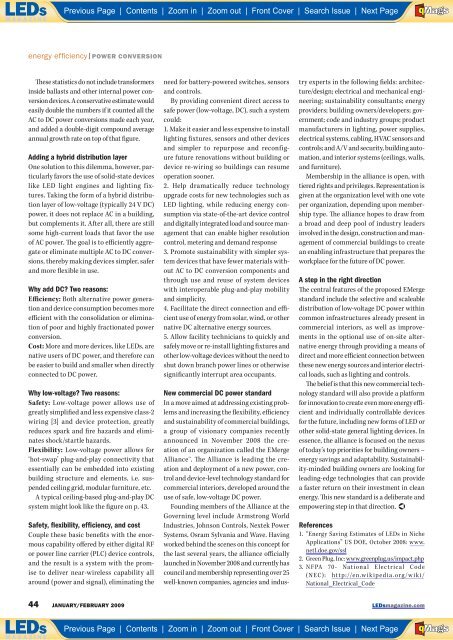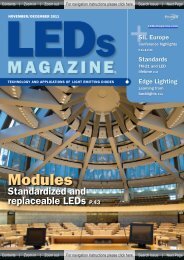Electronica - Beriled
Electronica - Beriled
Electronica - Beriled
Create successful ePaper yourself
Turn your PDF publications into a flip-book with our unique Google optimized e-Paper software.
Previous Page | Contents | Zoom in | Zoom out | Front Cover | Search Issue | Next Page<br />
A<br />
B<br />
E F<br />
M<br />
aG<br />
S<br />
energy effi ciency | POWER CONVERSION<br />
These statistics do not include transformers<br />
inside ballasts and other internal power conversion<br />
devices. A conservative estimate would<br />
easily double the numbers if it counted all the<br />
AC to DC power conversions made each year,<br />
and added a double-digit compound average<br />
annual growth rate on top of that figure.<br />
Adding a hybrid distribution layer<br />
One solution to this dilemma, however, particularly<br />
favors the use of solid-state devices<br />
like LED light engines and lighting fixtures.<br />
Taking the form of a hybrid distribution<br />
layer of low-voltage (typically 24 V DC)<br />
power, it does not replace AC in a building,<br />
but complements it. After all, there are still<br />
some high-current loads that favor the use<br />
of AC power. The goal is to efficiently aggregate<br />
or eliminate multiple AC to DC conversions,<br />
thereby making devices simpler, safer<br />
and more flexible in use.<br />
Why add DC Two reasons:<br />
Efficiency: Both alternative power generation<br />
and device consumption becomes more<br />
efficient with the consolidation or elimination<br />
of poor and highly fractionated power<br />
conversion.<br />
Cost: More and more devices, like LEDs, are<br />
native users of DC power, and therefore can<br />
be easier to build and smaller when directly<br />
connected to DC power.<br />
Why low-voltage Two reasons:<br />
Safety: Low-voltage power allows use of<br />
greatly simplified and less expensive class-2<br />
wiring [3] and device protection, greatly<br />
reduces spark and fire hazards and eliminates<br />
shock/startle hazards.<br />
Flexibility: Low-voltage power allows for<br />
‘hot-swap’ plug-and-play connectivity that<br />
essentially can be embedded into existing<br />
building structure and elements, i.e. suspended<br />
ceiling grid, modular furniture, etc.<br />
A typical ceiling-based plug-and-play DC<br />
system might look like the figure on p. 43.<br />
Safety, flexibility, efficiency, and cost<br />
Couple these basic benefits with the enormous<br />
capability offered by either digital RF<br />
or power line carrier (PLC) device controls,<br />
and the result is a system with the promise<br />
to deliver near-wireless capability all<br />
around (power and signal), eliminating the<br />
need for battery-powered switches, sensors<br />
and controls.<br />
By providing convenient direct access to<br />
safe power (low-voltage, DC), such a system<br />
could:<br />
1. Make it easier and less expensive to install<br />
lighting fixtures, sensors and other devices<br />
and simpler to repurpose and reconfigure<br />
future renovations without building or<br />
device re-wiring so buildings can resume<br />
operation sooner.<br />
2. Help dramatically reduce technology<br />
upgrade costs for new technologies such as<br />
LED lighting, while reducing energy consumption<br />
via state-of-the-art device control<br />
and digitally integrated load and source management<br />
that can enable higher resolution<br />
control, metering and demand response<br />
3. Promote sustainability with simpler system<br />
devices that have fewer materials without<br />
AC to DC conversion components and<br />
through use and reuse of system devices<br />
with interoperable plug-and-play mobility<br />
and simplicity.<br />
4. Facilitate the direct connection and efficient<br />
use of energy from solar, wind, or other<br />
native DC alternative energy sources.<br />
5. Allow facility technicians to quickly and<br />
safely move or re-install lighting fixtures and<br />
other low-voltage devices without the need to<br />
shut down branch power lines or otherwise<br />
significantly interrupt area occupants.<br />
New commercial DC power standard<br />
In a move aimed at addressing existing problems<br />
and increasing the flexibility, efficiency<br />
and sustainability of commercial buildings,<br />
a group of visionary companies recently<br />
announced in November 2008 the creation<br />
of an organization called the EMerge<br />
Alliance. The Alliance is leading the creation<br />
and deployment of a new power, control<br />
and device-level technology standard for<br />
commercial interiors, developed around the<br />
use of safe, low-voltage DC power.<br />
Founding members of the Alliance at the<br />
Governing level include Armstrong World<br />
Industries, Johnson Controls, Nextek Power<br />
Systems, Osram Sylvania and Wave. Having<br />
worked behind the scenes on this concept for<br />
the last several years, the alliance officially<br />
launched in November 2008 and currently has<br />
council and membership representing over 25<br />
well-known companies, agencies and industry<br />
experts in the following fields: architecture/design;<br />
electrical and mechanical engineering;<br />
sustainability consultants; energy<br />
providers; building owners/developers; government;<br />
code and industry groups; product<br />
manufacturers in lighting, power supplies,<br />
electrical systems, cabling, HVAC sensors and<br />
controls; and A/V and security, building automation,<br />
and interior systems (ceilings, walls,<br />
and furniture).<br />
Membership in the alliance is open, with<br />
tiered rights and privileges. Representation is<br />
given at the organization level with one vote<br />
per organization, depending upon membership<br />
type. The alliance hopes to draw from<br />
a broad and deep pool of industry leaders<br />
involved in the design, construction and management<br />
of commercial buildings to create<br />
an enabling infrastructure that prepares the<br />
workplace for the future of DC power.<br />
A step in the right direction<br />
The central features of the proposed EMerge<br />
standard include the selective and scaleable<br />
distribution of low-voltage DC power within<br />
common infrastructures already present in<br />
commercial interiors, as well as improvements<br />
in the optional use of on-site alternative<br />
energy through providing a means of<br />
direct and more efficient connection between<br />
these new energy sources and interior electrical<br />
loads, such as lighting and controls.<br />
The belief is that this new commercial technology<br />
standard will also provide a platform<br />
for innovation to create even more energy efficient<br />
and individually controllable devices<br />
for the future, including new forms of LED or<br />
other solid-state general lighting devices. In<br />
essence, the alliance is focused on the nexus<br />
of today’s top priorities for building owners –<br />
energy savings and adaptability. Sustainability-minded<br />
building owners are looking for<br />
leading-edge technologies that can provide<br />
a faster return on their investment in clean<br />
energy. This new standard is a deliberate and<br />
empowering step in that direction.<br />
References<br />
1. “Energy Saving Estimates of LEDs in Niche<br />
Applications” US DOE, October 2008: www. ___<br />
netl.doe.gov/ssl<br />
2. Green Plug, Inc: www.greenplug.us/impact.php<br />
3. NFPA 70- National Electrical Code<br />
(NEC): ____________________<br />
http://en.wikipedia.org/wiki/<br />
National_Electrical_Code<br />
_______________<br />
44 JANUARY/FEBRUARY 2009 LEDsmagazine.com<br />
Previous Page | Contents | Zoom in | Zoom out | Front Cover | Search Issue | Next Page<br />
A<br />
B<br />
E F<br />
M<br />
aG<br />
S

















